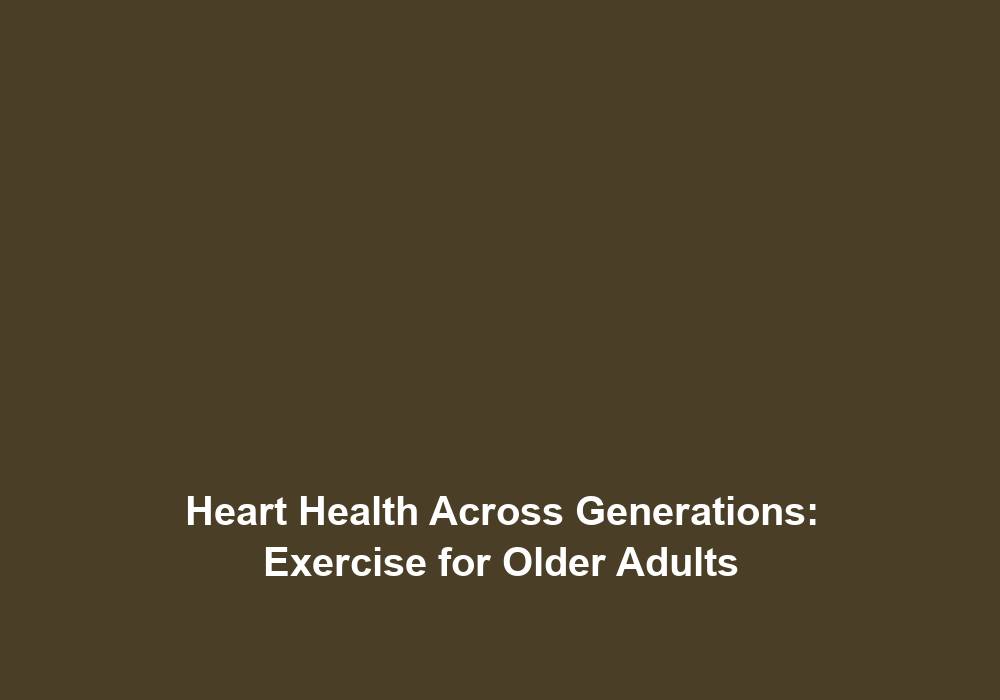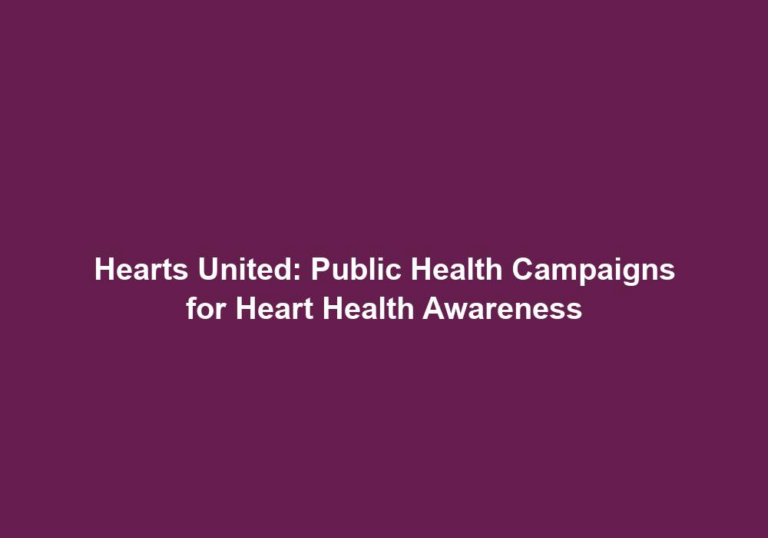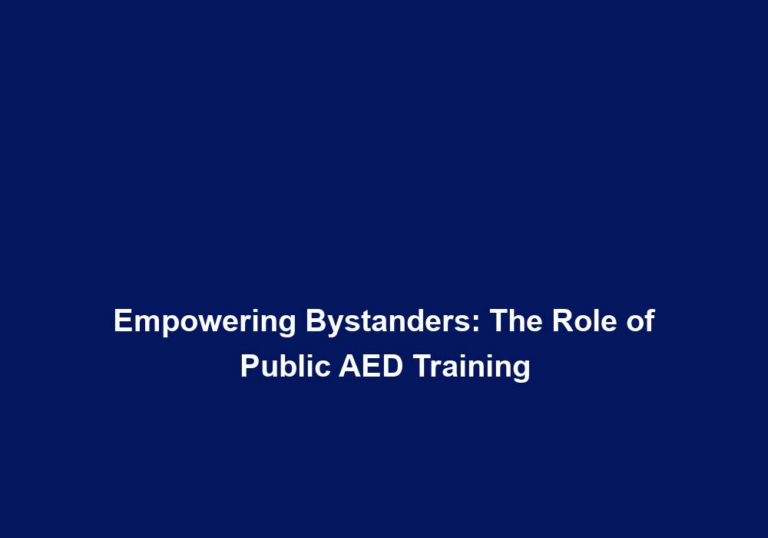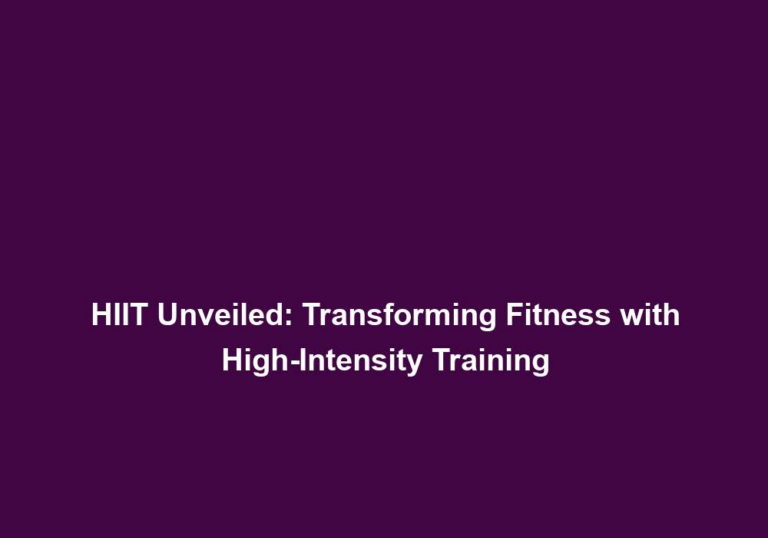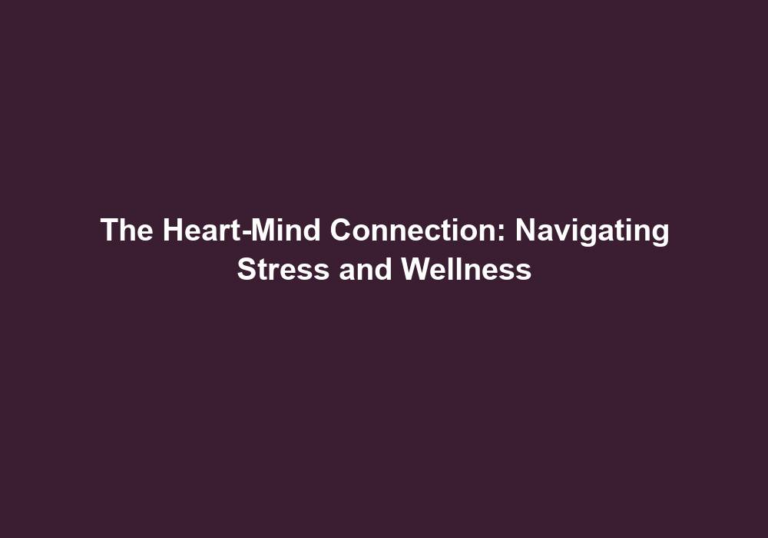Heart Health Across Generations: Exercise for Older Adults
Regular physical activity plays a crucial role in maintaining good heart health throughout our lives. As we age, the importance of exercise becomes even more significant, particularly for older adults. Engaging in appropriate exercises can help prevent cardiovascular diseases, reduce the risk of heart-related issues, and improve overall well-being. In this article, we will explore the benefits of exercise for older adults and provide valuable insights into the types of exercises that can promote heart health across generations.
The Importance of Exercise for Older Adults
Regular exercise offers numerous benefits to older adults. It not only improves cardiovascular health but also increases strength, enhances balance and coordination, reduces the risk of chronic diseases, enhances cognitive function, and increases overall quality of life. By incorporating physical activity into their daily routines, older adults can effectively manage and prevent various health conditions, such as heart disease, high blood pressure, diabetes, and obesity.
Understanding the Cardiovascular System
Before delving into specific exercises, it’s vital to understand how the cardiovascular system works. The heart, a powerful muscle, is responsible for pumping oxygenated blood throughout the body. Regular physical activity helps strengthen the heart, allowing it to pump blood more efficiently. Additionally, exercise promotes the growth of new blood vessels, improving blood circulation and reducing the risk of blockages that can lead to heart attacks or strokes.
Recommended Exercise Guidelines for Older Adults
The American Heart Association (AHA) recommends that older adults engage in at least 150 minutes of moderate-intensity aerobic activity per week or 75 minutes of vigorous-intensity aerobic activity. It is also recommended to perform muscle-strengthening activities targeting major muscle groups at least two days per week. However, it is crucial to consult with a healthcare professional before starting any exercise program to determine the most suitable activities based on individual health conditions and abilities.
Aerobic Exercises for Older Adults
Aerobic exercises are excellent for improving cardiovascular health and can be easily incorporated into older adults’ routines. They increase heart rate, breathing rate, and oxygen consumption, promoting a healthy cardiovascular system. Some suitable aerobic exercises for older adults include:
- Walking: This low-impact activity can be done outdoors or on a treadmill and is accessible to people of all fitness levels. Walking for at least 30 minutes a day can significantly improve heart health. It is important to choose comfortable and supportive footwear and walk on even surfaces to prevent falls.
- Swimming: The buoyancy of water reduces stress on joints, making swimming a gentle yet effective aerobic exercise. It works the entire body and provides an excellent cardiovascular workout. Swimming can also help improve flexibility and range of motion.
- Cycling: Whether on a stationary bike or outdoors, cycling is a low-impact exercise that improves heart health, strengthens leg muscles, and enhances overall endurance. It is important to adjust the bike seat and handlebars to ensure proper alignment and avoid strain on the back or knees.
- Dancing: Engaging in dance classes or simply dancing at home not only provides a fun and enjoyable way to exercise but also contributes to heart health and balance improvement. Dancing can be adapted to different fitness levels and preferences, making it a versatile activity.
Strength Training for Older Adults
In addition to aerobic exercises, older adults should also incorporate strength training activities into their exercise routines. Strength training helps build muscle, increase bone density, improve balance, and enhance overall physical performance. Some recommended strength training exercises for older adults include:
- Bodyweight exercises: Squats, lunges, push-ups, and planks are effective bodyweight exercises that can be modified to suit individual fitness levels. They don’t require any equipment and can be done at home. Bodyweight exercises help improve strength and stability, and they can be adapted to target specific muscle groups.
- Resistance band exercises: Using resistance bands provides a gentle yet effective way to tone muscles and improve overall strength. These lightweight and portable bands can target various muscle groups and offer a safe and convenient option for older adults.
- Weightlifting: Older adults can benefit from weightlifting exercises using dumbbells or weight machines. It is advisable to start with light weights and gradually increase the intensity under proper supervision. Weightlifting helps improve bone density and muscle strength, promoting overall physical function and reducing the risk of falls.
Flexibility and Balance Exercises
Maintaining flexibility and balance is essential for older adults to prevent falls and injuries. Flexibility exercises help improve joint mobility and prevent stiffness, while balance exercises enhance stability. Some effective flexibility and balance exercises for older adults include:
- Yoga: Practicing yoga regularly improves flexibility, balance, and overall body strength. It also promotes relaxation and reduces stress. Yoga poses can be modified to accommodate different levels of flexibility and can be practiced at home or in a class setting.
- Tai Chi: This ancient martial art focuses on gentle flowing movements, promoting balance, flexibility, and relaxation. Tai Chi is suitable for individuals of all fitness levels and can help improve posture and coordination. Joining a Tai Chi class or following instructional videos can provide guidance for proper form and technique.
- Stretching exercises: Stretching exercises are vital for maintaining flexibility. It is important to stretch the major muscle groups before and after exercise sessions to prevent muscle soreness and injuries. Stretching can be done anywhere and anytime, making it a convenient activity for older adults to incorporate into their daily routines.
Safety Considerations for Older Adults
While exercise is highly beneficial for older adults, certain precautions should be taken to ensure safety and prevent injuries. Here are some important safety considerations to keep in mind:
- Consult with a healthcare professional before starting any exercise program to assess individual health conditions and receive guidance on suitable activities.
- Start with low-intensity exercises and gradually increase the duration and intensity to allow the body to adjust and minimize the risk of overexertion.
- Warm up before exercise and cool down afterward to increase blood flow to the muscles and prevent muscle strains. Gentle stretching can be included in the warm-up and cool-down routines.
- Stay hydrated and drink plenty of water during workouts to maintain proper hydration levels.
- Listen to the body and rest when necessary. Overexertion can lead to injuries, so it is important to allow for adequate recovery time.
- Use appropriate footwear and exercise on suitable surfaces to prevent falls and ensure stability during exercises.
- If necessary, use assistive devices like canes or walkers to ensure stability and prevent accidents. These devices can provide additional support and confidence during exercise sessions.
Conclusion
Regular exercise is a vital component of maintaining heart health across generations, particularly for older adults. By incorporating a variety of aerobic, strength training, flexibility, and balance exercises into their routines, older adults can improve cardiovascular health, reduce the risk of chronic diseases, and enhance overall well-being. It is important to remember that individual abilities and health conditions should be considered when choosing exercise activities, and consulting with a healthcare professional is crucial to ensure safe and effective workouts. Let’s prioritize exercise and take proactive steps towards maintaining a healthy heart throughout our lives!

